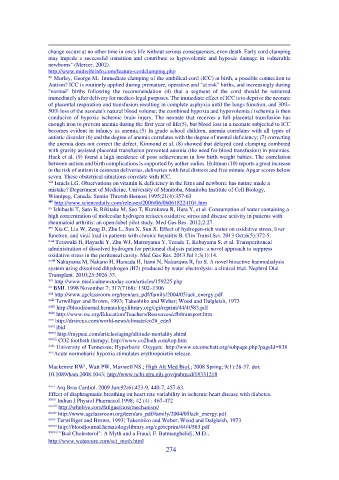Page 274 - Wasserstoff Medizin
P. 274
change occurs at no other time in one's life without serious consequences, even death. Early cord clamping
may impede a successful transition and contribute to hypovolemic and hypoxic damage in vulnerable
newborns" (Mercer, 2002).
http://www.midwifeinfo.com/feature-cordclamping.php
xii Morley, George M. Immediate clamping of the umbilical cord (ICC) at birth, a possible connection to
Autism? ICC is routinely applied during premature, operative and "at risk" births, and increasingly during
"normal" births following the recommendation (4) that a segment of the cord should be retrieved
immediately after delivery for medico-legal purposes. The immediate effect of ICC is to deprive the neonate
of placental respiration and transfusion resulting in complete asphyxia until the lungs function, and 30%-
50% loss of the neonate's natural blood volume; the combined hypoxia and hypovolemia / ischemia is then
conducive of hypoxic ischemic brain injury. The neonate that receives a full placental transfusion has
enough iron to prevent anemia during the first year of life(5), but blood loss in a neonate subjected to ICC
becomes evident in infancy as anemia.(5) In grade school children, anemia correlates with all types of
autistic disorder (6) and the degree of anemia correlates with the degree of mental deficiency; (7) correcting
the anemia does not correct the defect. Kinmond et al. (8) showed that delayed cord clamping combined
with gravity assisted placental transfusion prevented anemia (the need for blood transfusion) in preemies.
Hack et al. (9) found a high incidence of poor achievement in low birth weight babies. The correlation
between autism and birth complications is supported by aother sudies. Hultman (10) reports a great increase
in the risk of autism in cesarean deliveries, deliveries with fetal distress and five minute Apgar scores below
seven. These obstetrical situations correlate with ICC.
xiii Israels LG. Observations on vitamin K deficiency in the fetus and newborn: has nature made a
mistake? Department of Medicine, University of Manitoba, Manitoba Institute of Cell Biology,
Winnipeg, Canada. Semin Thromb Hemost 1995;21(4):357-63
xiv http://www.sciencedaily.com/releases/2006/06/060618224104.htm
xv Ishibashi T, Sato B, Rikitake M, Seo T, Kurokawa R, Hara Y, et al. Consumption of water containing a
high concentration of molecular hydrogen reduces oxidative stress and disease activity in patients with
rheumatoid arthritis: an open-label pilot study. Med Gas Res. 2012;2:27.
xvi Xia C, Liu W, Zeng D, Zhu L, Sun X, Sun X. Effect of hydrogen-rich water on oxidative stress, liver
function, and viral load in patients with chronic hepatitis B. Clin Transl Sci. 2013 Oct;6(5):372-5.
xvii Terawaki H, Hayashi Y, Zhu WJ, Matsuyama Y, Terada T, Kabayama S, et al. Transperitoneal
administration of dissolved hydrogen for peritoneal dialysis patients: a novel approach to suppress
oxidative stress in the peritoneal cavity. Med Gas Res. 2013 Jul 1;3(1):14.
xviii Nakayama M, Nakano H, Hamada H, Itami N, Nakazawa R, Ito S. A novel bioactive haemodialysis
system using dissolved dihydrogen (H2) produced by water electrolysis: a clinical trial. Nephrol Dial
Transplant. 2010;25:3026-33.
xix http://www.medicalnewstoday.com/articles/159225.php
xx BMJ. 1998 November 7; 317(7168): 1302–1306
xxi http://www.agclassroom.org/teen/ars_pdf/family/2004/05lack_energy.pdf
xxii Terwilliger and Brown, 1993; Takenhiko and Weber; Wood and Dalgleish, 1973
xxiii http://bloodjournal.hematologylibrary.org/cgi/reprint/44/4/583.pdf
xxiv http://www.rsc.org/Education/Teachers/Resources/cfb/transport.htm
xxv http://drsircus.com/world-news/climate/co2#_edn5
xxvi ibid
xxvii http://raypeat.com/articles/aging/altitude-mortality.shtml
xxviii CO2 footbath therapy; http://www.co2bath.com/top.htm
xxix University of Tennessee; Hyperbaric Oxygen; http://www.utcomchatt.org/subpage.php?pageId=838
xxx Acute normobaric hypoxia stimulates erythropoietin release.
1
Mackenzie RW , Watt PW, Maxwell NS.; High Alt Med Biol.; 2008 Spring; 9(1):28-37. doi:
10.1089/ham.2008.1043; http://www.ncbi.nlm.nih.gov/pubmed/18331218
xxxi Arq Bras Cardiol. 2009 Jun;92(6):423-9, 440-7, 457-63.
Effect of diaphragmatic breathing on heart rate variability in ischemic heart disease with diabetes.
xxxii Indian J Physiol Pharmacol 1998; 42 (4) : 467-472
xxxiii http://whnlive.com/fatigue/care/mechanism/
xxxiv http://www.agclassroom.org/teen/ars_pdf/family/2004/05lack_energy.pdf
xxxv Terwilliger and Brown, 1993; Takenhiko and Weber; Wood and Dalgleish, 1973
xxxvi http://bloodjournal.hematologylibrary.org/cgi/reprint/44/4/583.pdf
xxxvii "Bad Cholesterol": A Myth and a Fraud; F. Batmanghelidj, M.D.;
http://www.watercure.com/sci_myth.html
274

